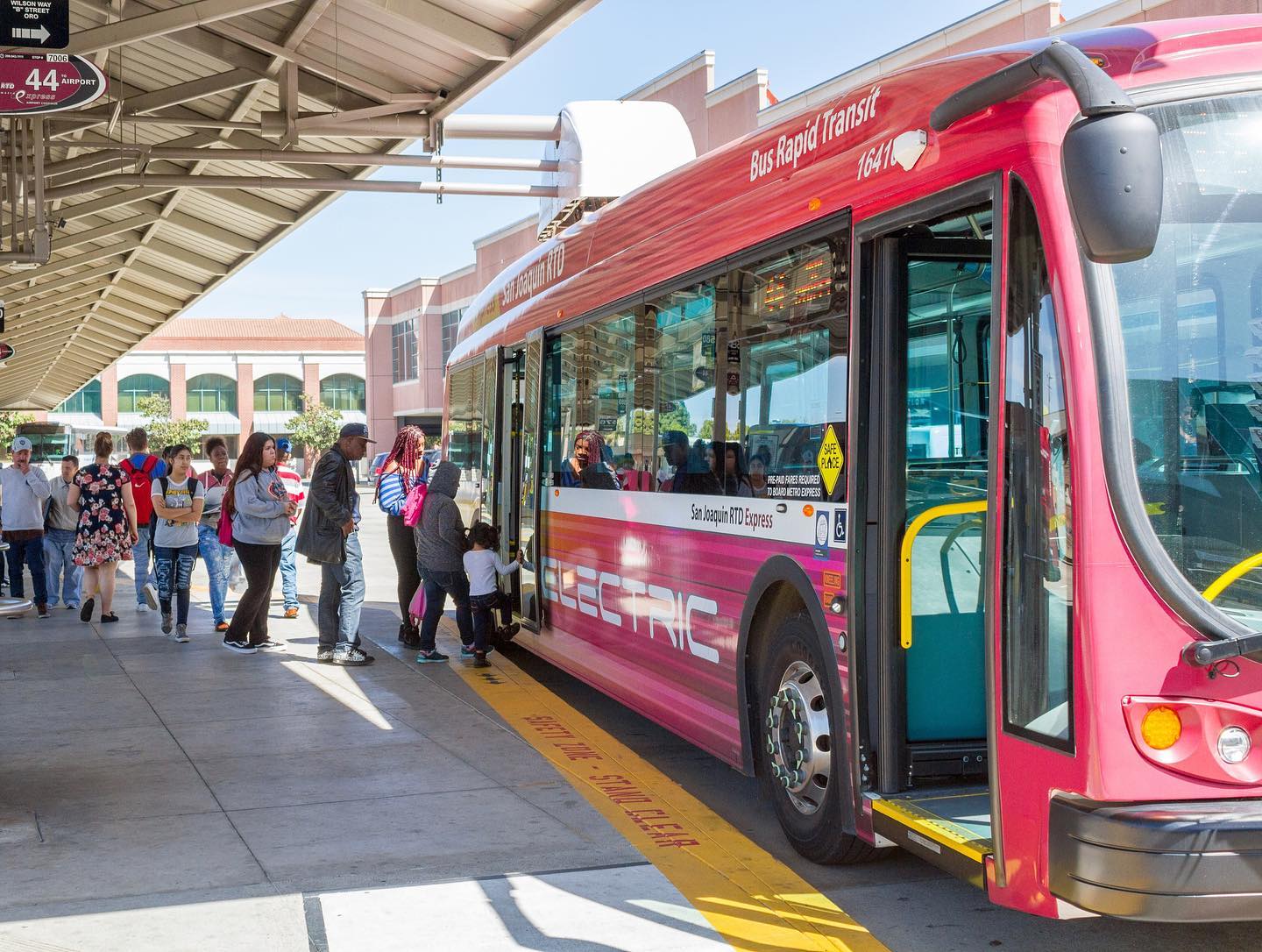In partnership with: Pacific Gas and Electric (PG&E)
Installing charging infrastructure and route planning takes time, commitment, and experience to ensure that the results save fleets time and money. As an early adopter of cleantech, San Joaquin Regional Transit District (RTD) had few best practices to lean on before starting their electrification project. Based in Stockton, Calif., the agency serves a geographic area of more than 1,400 square miles and plans to transition to 100% electric buses by 2025. For this reason, RTD partnered with the Pacific Gas & Electric Company (PG&E) to receive expert guidance on how to scale up it’s infrastructure to support new electric bus deployments.
In 2013, RTD was the first transit agency in Northern California to place a 100% battery-electric bus into service, starting with a pair of Proterra electric buses thanks to a grant from the California Energy Commission. By 2018, they added 15 more Proterra buses and created the nation’s first all-electric bus rapid transit route.
By 2018, RTD added 15 more Proterra buses and created the nation’s first all-electric bus rapid transit route.
Operating a transit fleet with a mix of older and newer generation buses presented a challenge. The older buses operate with a range of approximately 30 to 50 miles, and cannot depend on overnight charging alone. Whereas the newer buses — 10 with 105 kWh batteries and five with 440 kWh batteries — have a longer range of about 130 miles and can rely on overnight charging.
With guidance from the PG&E team, RTD moved forward with testing a mix of on-route overhead fast-charging and overnight depot charging at lower energy levels. The project resulted in significant cost savings for the fleet, as well as an easier protocol for managing the mix of electric buses.
Charging Towards the Best TCO
In three locations, RTD installed a combination of four in-route, 500 kW overhead chargers and five 60 kW depot chargers. This setup not only provides continued power for the lower range buses but also provides the most potential for infrastructure and fuel cost savings.
 The Regional Transportation Center has five 60 kW depot chargers for overnight fueling of the longer-range electric buses. The Downtown Transit Center, Stockton’s largest transit hub, includes two 500 kW Eaton pantograph overhead fast chargers with charge management software, which serve four short routes. And the Union Transfer Station employs two Siemens overhead fast chargers, with plans to add a battery-electric storage system.
The Regional Transportation Center has five 60 kW depot chargers for overnight fueling of the longer-range electric buses. The Downtown Transit Center, Stockton’s largest transit hub, includes two 500 kW Eaton pantograph overhead fast chargers with charge management software, which serve four short routes. And the Union Transfer Station employs two Siemens overhead fast chargers, with plans to add a battery-electric storage system.
RTD installed demand management software at the Downtown Transit Center to address high demand costs and determine whether managed charging could reduce electricity bills while still meeting the operational needs for the bus routes. While more advanced protocol is necessary for high-energy load transit fleets, the agency did see cost savings with the software. Most notably, the demand management software proved to be highly effective at controlling costs by capping average demand in any 15-minute window, which is helpful with automated charging.
Choosing Between Plugin and Overhead Charging
Transit fleets have a few options to choose from when deciding on the best charging infrastructure setup. For those like RTD that have a mix of shorter- and longer-range electric buses, understanding the difference between the options is a first step to identifying what will work best to keep buses charged and costs down.

Plug-in charging, installed at RTD’s overnight depot, is done by manually plugging a charging cord into an EV’s charging receptacle. Plug-in charging is by far the most common interface used today. These are considered “conductive” systems because power is transferred to the vehicle via conductors in the plug and receptacle. There are many different plugin interfaces based on various standards.
Overhead systems, such as the ones RTD used at their in-route charging stations, are another type of conductive interface that provides power by connecting an EV to a DC fast charger using a pantograph. Because the pantograph can handle large conductors that would be difficult for an individual to manage in a manual plug-type interface, overhead systems can charge at higher power levels than plug-type interfaces.
Overhead systems are another type of conductive interface that provides power by connecting an EV to a DC fast charger using a pantograph.
Lastly, while not as widely adopted as the first two options, wireless charging is a nonconductive interface that transfers power from a ground-mounted “transmitter” coil to a receiving coil mounted to the bottom of a vehicle. In practice, it is like wireless cell phone charging. The power received by the receiving coil is provided to the vehicle’s AC charging electronics as if the vehicle were connected to a plug-in AC charger. Wireless charging systems with power levels as high as 250 kW have been demonstrated. Wireless charging typically requires retrofitting the receiving coil to an EV because medium- and heavy-duty vehicle manufacturers do not currently offer wireless EV charging interfaces as an integrated option.
Learn more about charging infrastructure options and design in our EV Fleet Charging Guidebook.
Local utilities can help fleets determine the best setup early on in the electrification process. By teaming up with PG&E, RTD saw significant savings for both infrastructure installation and fuel costs.
Savings Show Positive Results
In addition to design support, RTD enrolled in PG&E’s new Business EV (BEV) rate plans and realized cost savings at all three charging sites. The BEV rate plans offer two subscription rates, which combine a monthly subscription charge based on energy usage and a time-of-use rate. PG&E worked with the transit agency to determine the best rate based on energy load and charging schedules to keep fuel costs low.
By implementing a well-suited charging infrastructure, demand management software, and PG&E’s BEV rates, RTD saved nearly $15,000 at the three stations combined in the first month on the new rate plan. Overall, the fleet reduced its fuel cost per mile from $2.31 to $0.68.
| Site | Billing Details | June Bill A10 rate |
July Bill BEV rate |
Savings |
| RTC | 5 Depot Chargers;
No time-of-use charges |
$3,181 | $1,001 | $2,181 |
| DTC | 2 Overhead Chargers;
Demand Management Software in Place |
$8,334 | $1,707 | $6,627 |
| UTS | 2 Overhead Chargers;
No Demand Management Software |
$9,437 | $3,423 | $6,014 |
| Fleet cost per mile | $2.31 | $0.68 | $1.63 | |
The partnership with PG&E helped RTD save on costs while advancing the state of knowledge on how to deploy electric transit buses. The utility worked closely with the transit agency to give expert guidance on the best installation practices, how to understand billing rate tiers, and how to implement the best charging schedules to reduce costs.
To learn more about what lessons RTD learned during their EV deployment, check out the full case study.
Utility Partners are Critical to Project Success
PG&E’s experience with fleet electrification projects allows the utility to assist transit agencies like RTD by educating them on the process of obtaining and installing chargers, as well as the opportunities and limitations associated with certain strategic decisions on charging infrastructure.
The EV Fleet program is available to fleets through the end of 2024. With most EV projects taking fleets on average two years to complete, right now is the time to start. To get help with your electrification plans, submit an interest form to connect with an EV Fleet specialist. And learn more about eligibility requirements, additional funding opportunities, infrastructure best practices, and more at pge.com/evfleet.



